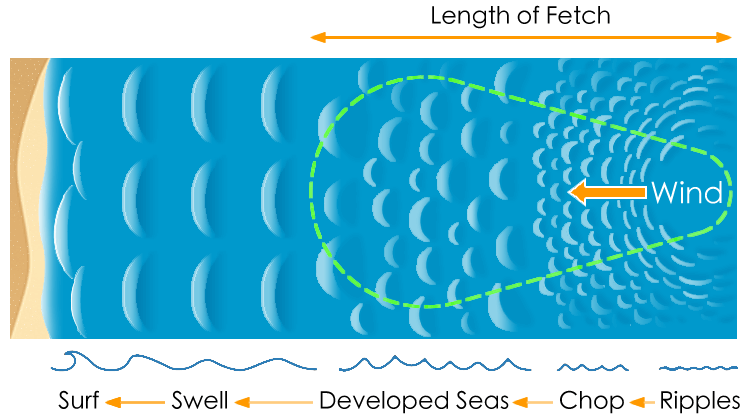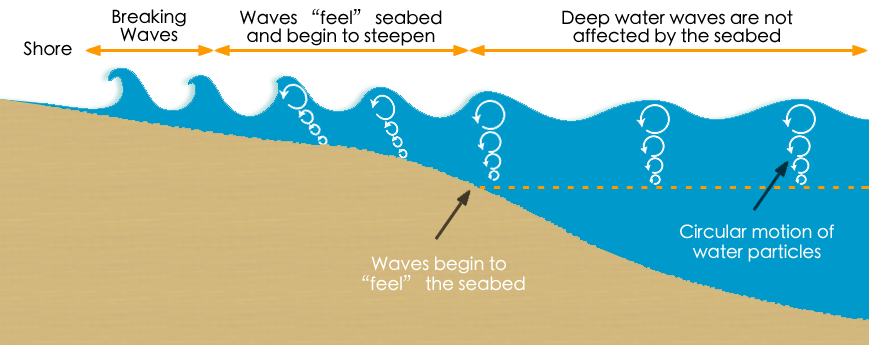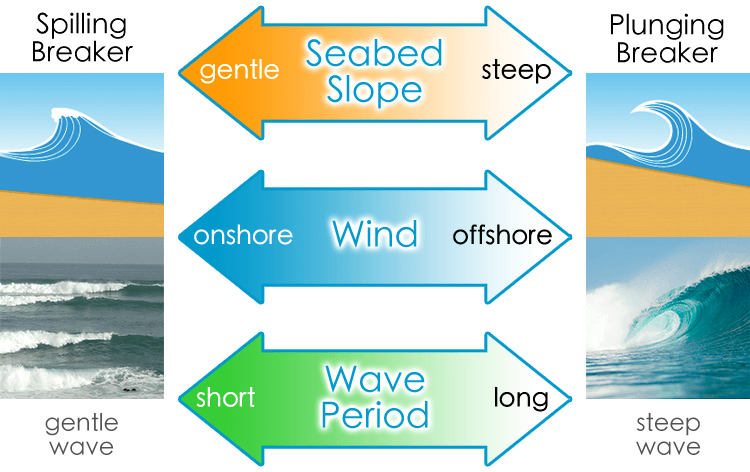In our first surf article, "
How to Read a Surf Forecast
," we learned just that, how to read a surf forecast. That will help you a lot in predicting what the surf conditions will be like. However,
the more you know about how waves are created, the better you will be in predicting the surf.
This article builds on the previous one, so if you haven’t read it yet, we suggest that you read it first.
As a surfer, you know that every wave is different. Every surf session is different. That is part of the beauty and excitement of surfing - waves are never the same, otherwise surfing would get boring. Unless you’re able to ride Kelly Slater’s Wave every day!
So why are waves small and choppy one day, then big and clean on another? We’ll try to answer that in this article.
First, it is important to understand that a wave is not water that is moving forward towards the coast. Instead, a wave is energy that is passing through the water. Where does that energy come from? It initially comes from the Sun. The energy from the Sun enters the Earth’s atmosphere, creating circulating air systems (storms) that form over the ocean. The wind energy generated from those storms is then transferred from the air to the water, creating ripples, and thus beginning the birth of the wave that you will eventually surf on when it reaches your surf spot.
So in a nutshell, waves are created by wind. These wind-generated waves are far out to sea (ideally), and will gradually begin to leave the wave-generating area. The energy travels within the water in the form of swell, while the water itself moves in isolated, circular motions. The swell moves across the ocean surface, organizing itself into groups of waves heading towards the coastline.
Again, waves are formed as energy passes through the water. Waves do not move the water forward. Water particles move in a circular pattern, more or less returning to their point of origin once the wave has passed through, as seen in the following video.
There are three main factors that determine the size and quality of a swell:
1. Wind Strength - The stronger the wind, the bigger the waves. The wind must be moving faster than the wave crests for energy to be transferred.
2. Wind Duration - How long the wind blows. The longer the wind blows, the larger the wave will be.
3. Fetch - The "length" (distance) wind blows over water in the open sea. This is the uninterrupted distance over which the wind blows without significant change in direction. The greater the fetch, the larger the wave will be.
The greater these three factors, the larger the swell and the longer the swell period.

Swell Period is the time it takes, in seconds, for successive waves to pass the same fixed point. Swell period is an indication of the amount of energy transferred by the wind to the ocean. A longer period swell will result in waves that are both bigger and more powerful when they reach the coast.
Wind swells originate relatively close to shore and are usually still somewhat disorderly when they reach land, where they are often accompanied by the same onshore winds that created them. Wind swells tend to break in deeper water and with less force. They usually have a period of around 10 seconds or less.
Groundswells form a lot further out to sea and tend to produce a better quality wave to surf. Ground swells create a more dramatic wave. The longer period waves will move quickly and get into shallow water before starting to break, creating a breaking wave that will be steeper and faster. Swells with a period of around 13 seconds or more are considered groundswells.
Though groundswells are preferable for surfing, there can still be fun, surfable waves with an 8 or 9 second period. Many beach breaks prefer swells in the 9-13 second range, and would otherwise turn into giant close-outs with a longer period groundswell.
When waves get very close to the shore and begin traveling over shallow water, they break. They are influenced by the topography (or bathymetry ) of the seabed, which causes the wave to slow down, bend (called refraction ), and increase in size. The wave breaks when the lower part of the wave ( trough ) slows down due to friction with the seabed, and the upper part of the wave ( crest ) continues forward maintaining its speed and causing it to spill over. The depth at which the seabed starts to affect the wave speed is about 0.8 times the period squared: 0.8 x period². This is about the time when the energy is transferred from the wave into you, allowing you to enjoy this amazing thing we call surfing!

The bathymetry of the seabed determines exactly how the wave will spill over. In general, the steeper the the seabed, the steeper the wave , and the more violently it will rear up and break. Many heavy, barreling waves (called “Plunging Breakers”) are formed when deep water suddenly gives way to very shallow water (reef breaks such as Pipeline in Hawaii). Gentler waves (called “Spilling Breakers”) suitable for beginners will break when this transition is much more gradual, over seabeds characterized by a shallow gradient (beach breaks similar to Wushi Harbor ).
The way a wave breaks depends mostly on the slope of the seabed and the abruptness of the deep water to shallow water transition (discussed above), but there are two other factors that play into it, the wind and the wave period. As explained in the image below, the following three factors influence how the wave breaks:
1. The slope of the seabed and its transition from deep water to shallow water.
2. The direction and strength of the wind.
3. The period of the wave.
